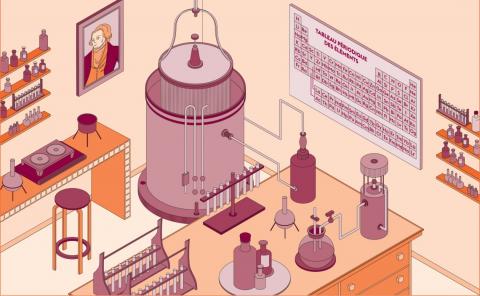
Chemistry, tell me your story
As 2019 was designated “Year of chemistry, from primary school to university” in France and the “International Year of the Periodic Table of Chemical Elements” by UNESCO, the historians of Université Paris-Saclay decided to set down the main changes for chemistry and its teaching over the centuries.
The child watched his father as he banged stones together, unleashing sparks. He memorised his actions and acquired the knowledge of the first men who had mastered fire. Fire was the first chemical transformation used by humans, more than 400,000 years ago. The child grew and took it into his head to heat earth, which, to his great surprise, changed colour and hardened. As well as improving food through cooking, fire made it possible to create new materials. The use of chemical transformations was thus based on knowledge and expertise that was passed on through learning. As well as that knowledge of the “chemical arts”, Greek philosophers began to speculate on the meaning of nature a few centuries before Christ. However, they did not conduct experiments, which they thought were too susceptible to deception. They believed that the legitimate form of knowledge production should be based on common sense and knowledge that was accessible to all.
In about the 2nd century AD, alchemy developed in continuity with the practice of gold and silversmithing. Alchemists’ quest for the philosopher’s stone and a panacea distanced them from Greek rationalism. Their work led to the development of many techniques, instruments and laboratory protocols.
In Europe, it was only in the 17th century that a new, legitimate way of building knowledge emerged: experimentation. Alchemy gave way to chemistry as a rational scientific subject. Its aim was to understand the structure of matter and its transformations through a coherent theory. At the beginning of the 17th century, the first free, public chemistry class was established in the King’s garden, the ancestor of the current Museum of natural history, to complete the training of doctors and apothecaries. In the 17th and then 18th centuries, “chemists’” turned to matters of analysis. They had before them a considerable variety of materials, which were essentially compounds, but did not have any way to separate their different components.
Virginie Fonteneau, director of the Laboratory for science and technical studies (EST) at Université Paris-Sud explained: “Knowing how to analyse the products of a chemical transformation, whether solid, liquid or gaseous, was crucial for Antoine Lavoisier. The understanding of matter thus went hand in hand with the development of the tools necessary for chemical separations. Chemistry is taught through analytical means.” Antoine Lavoisier was guillotined in 1794. Can you not hear the resonance of “The Republic has no need of scholars”? One of his most important discoveries was the role, in combustion, of what he called “oxygen”. Our understanding of matter and its transformations was shaken.
A new revolution was brewing. As Lavoisier had done his utmost to identify the components of chemical reactions, in England, in 1803, John Dalton (1766-1844) proposed an atomic theory to explain the difference in solubility of gases. “This confronted chemists with a choice that divided them. Should they accept the atomic hypothesis even though they couldn’t prove it through an experiment? That hypothesis turned out to be heuristic for organic chemistry through the use of imagery enabling a ’mental image’ of molecules, without knowing what actually linked the atoms,” Virginie Fonteneau stated. “At the time, chemists made great use of laboratory benches, while simultaneously calling on their imagination in a way that was simply unverifiable. Historians wondered, for example, how August Kekulé had imagined the cyclic compound benzene in 1865.”
“The use of imagery is well-known in teaching,” she continued. “The French education system was then dominated by mathematics, which were the key to accessing the most prestigious schools. That predominance did not exist in England or Germany. In France, the idea of drawing and devising a visual for molecules was not considered good practice.” In France, atomic notation was not taken up in specialised education until 1882 and was only widely disseminated in textbooks in 1891!
Chemistry further developed in the 19th and 20th centuries, buoyed by the Industrial Revolution and the unprecedented progress made in knowledge and techniques. New branches of chemistry emerged, including quantum chemistry, supramolecular chemistry, which earned Jean-Marie Lehn the Nobel prize, biochemistry and the analysis of the macromolecules of life.
The child who learned to make fire by knocking flints together is now working on a chemistry PhD, as well as high performance computing using super calculators, but there is still that same gleam in his gaze as he works in the fascinating world of chemistry.
The original version of this article was published in L'Edition #11.
